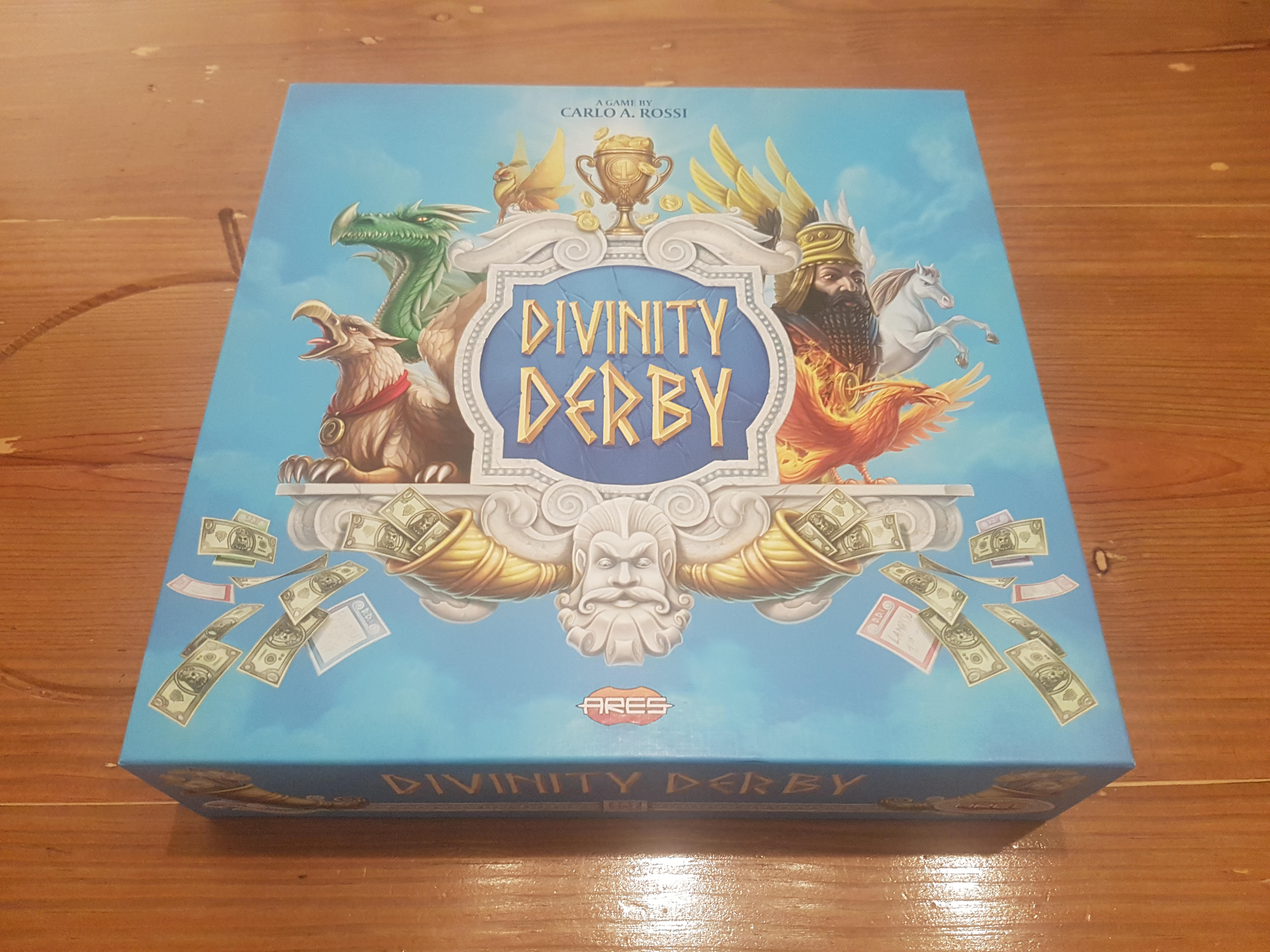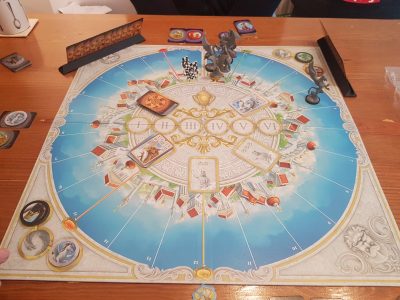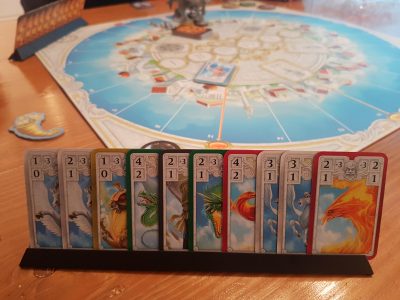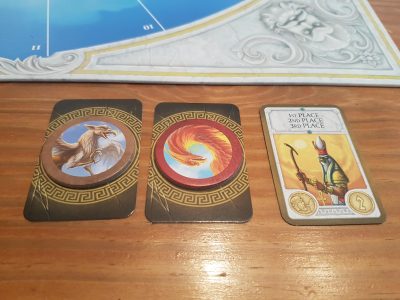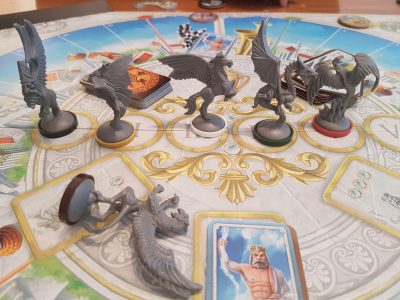Divinity Derby, released last year after a successful Kickstarter campaign, is a racing board game with betting and wagering. The game, from designer Carlo A. Rossi and publisher Ares Games, sees 3 – 6 players using variable player powers, racing around Mount Olympus and Zeus himself declaring the winner. However, is this an almighty board game or just another Kickstarter title? Let’s find out!
Divinity Derby is a betting game more than race, and like Camel Up none of the mythical creatures are assigned to players. All are placed on the starting line with tokens representing each placed around the edge of the board, the amount depending on the player count. Next is the part of the setup that sets Divinity Derby apart from other race titles. Cards are dealt evenly between card holders that sit between players, again the amount depending on the player count. This means each player can see the cards on a holder to their left and one to their right.
Once this is done players are free to look at the two card holders they can see, to determine what cards will be available to them. At this stage each player is going to bet on an outcome of the race. Utilizing cards such as “1st or Disqualified”, “Last Place” or “1st, 2nd or 3rd” a player secretly chooses a card and then takes the token associated with the creature they want to bet on. For example, if you can see only a limited number of Green Dragon cards then you might play a betting card for last place and take the Green Dragon token to place on top of it. Going clockwise around the table from the starting player each player will make two bets, one at a time, before the race begins.
On a turn a player will choose a card from both of the holders they can see. Each card will have a top and bottom number, with the latter always being the lower figure. Players will choose to play one of the two cards first to move that creature the top number of spaces, followed by playing the second card for its bottom number. Some cards allow the player to move the first creature an extra 3 spaces, via a “dirty trick”. This adds in the risk element of disqualification into the mix. Instead of simply discarding a card played as a dirty trick it is added into the Zeus pile, for the end of the round.
Play continues with players taking turns to move the creatures around the board. When the first creature crosses the half way point of the track a final round of betting is initiated. After this, the round continues as normal until all the movement cards have been played. At this point, the Zeus cards are shuffled with two being drawn randomly from the small deck of cards. If any cards drawn match a creature it is disqualified. Draw only Zeus cards and no one is disqualified. At this point it is time to see which bets were correct, based on the order of the creatures, that can be then set aside for the end game scoring. The game suggests playing three rounds back to back, though if limited for time after a round players could count to see whom won straight away.
To mix things up players can add in god powers. These are unique player powers that can affect the race. Each player will get a set of three powers, each with their own activation requirements. A lot refer to when a creature is moved, resulting in additional or negative. There are then more powerful abilities, called Fate, that require creatures to land on preselected spaces, designated by Fate tokens that players get to choose during setup. Without these godly power cards Divinity Derby is effectively a rethemed horse race with betting. Thankfully, once these powers are added in the theme starts to shine through a little more.
This is less a race to a finish line than a race against time to get as far as possible. Despite Divinity Derby hitting the table countless times, only once have I seen one of the mythical beasts cross the finish line, and that was a single miniature by the skin of its teeth. Most commonly players will find that the creatures will get to around 3/4s of the way around the track. This is slightly odd as the first half of the board the creatures will bound around, triggering the final betting. Once this has happened it is rare to see huge movement past the line. Slightly irritatingly there is a rule that separates two creatures on the same space, as intuitively players think of a photo like finish, where they’d be joint. Every time this happens I have to return to the rulebook to see that the last to arrive there is ahead in the rankings.
The unique element, that hook which will keep people coming back, is the way you draw cards. Not only does this mean that cards you may want to play as high cards get played by opponents as lower values, spoiling best made plans, but it introduces the ability to bluff opponents. As particular opponents can see half of the cards you are drawing from they will read into what bets you make. For instance, if the card holder an opponent can see has a handful of decent, high numbered cards, of one colour then they will see a bet that you on that creature as a sign you’ll be trying to get it to win. Psych them out by choosing it for being last or even disqualified, via the dirty tricks, and they may try to follow suit mistakenly, ruining their bet. Of course, this can backfire, but that’s part of the fun!
Mechanically the game works with 3 – 6 players but for the sake of comfortably sitting around a table, and being able to see both card holders without massive amounts of leaning, 3 isn’t exactly the best fit. 4 player stands out and being the best player count due to this with each card holder then symmetrically placed at the four corners of the board. Divinity Derby has a sense of push your luck mechanics, at its core, via the disqualification system. Though this is very similar to how the dragon in Clank! deals out damage, with only two cards pulled in a round, it feels a lot more random. This randomness and lack of control over the outcome of the race increase alongside the player count, further cementing 4 players as the optimal count.
As with a lot of games that originated on Kickstarter the production quality is rather high. The game board is vibrant in colour and of decent thickness, the card finish is perfect for shuffling and then there are some rather beautiful miniatures that represent the mythical creatures, from the iconic Pegasus to the lesser known Lamassu. Alas, there is an aspect that lets the game down and that is while the colours of tokens are bright and easily distinguishable, the darkened colours used for bases on the minis, makes it hard to tell them apart. It can be hard to visually see the difference between the likes of the dark brown from black at a quick glance, occasionally leading to moving the wrong miniature, despite what they look like.
Divinity Derby has some great aspects to it. The bidding mechanics with shared information is a great twist, that adds some tension into the mix as you hope the cards you want stay available. It is a shame that for the basic game, without the god powers, the theme feels pretty much strapped on. Conversely, as Divinity Derby then looks and plays more like a horse race it is easy to teach. After a play or two though the player powers do need to be added to do add some variety to the mix, and they do this without significantly making the game more complicated. Overall, if you’re looking for something light-hearted without any major brain taxing decisions, this might be an experience for you!
[Editor’s Note: Divinity Derby was provided to us by the publisher for the review.]

